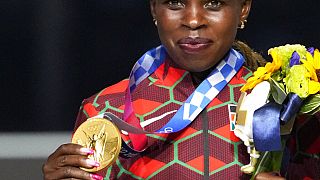USA
Award-winning American author and artist Faith Ringgold has died at the age of 93.
Ringgold broke barriers for Black female artists and became famous for her richly colored and detailed quilts combining painting, textiles and storytelling,
The artist's assistant, Grace Matthews, said that Ringgold died Friday night at her home in Englewood, New Jersey. Matthews said Ringgold had been in failing health.
Ringgold’s highly personal works of art can be seen in collections across the United States and beyond, but her rise to prominence as a Black artist wasn't easy in an art world dominated by white men. But her rise to prominence as a Black artist wasn’t easy in an art world dominated by white males and in a political cultural where Black men were the leading voices for civil rights.
Social activism
A founder in 1971 of the Where We At artists collective for Black women, Ringgold became a social activist, frequently protesting the lack of representation of Black and female artists in American museums.
“I became a feminist out of disgust for the manner in which women were marginalized in the art world,” she told The New York Times in 2019. “I began to incorporate this perspective into my work, with a particular focus on Black women as slaves and their sexual exploitation.”
In her first illustrated children’s book, “Tar Beach,” the spirited heroine takes flight over the George Washington Bridge. The story symbolized women’s self-realization and freedom to confront “this huge masculine icon — the bridge,” she explained.
The story is based on her narrative quilt of the same name now in the permanent collection of the Solomon R. Guggenheim Museum in New York.
While her works often deal with issues of race and gender, their folk-like style is vibrant, optimistic and lighthearted and often reminiscent of her warm memories of her life in Harlem.
Challenging stereotypes
Ringgold introduced quilting into her work in the 1970s after seeing brocaded Tibetan paintings called thangkas. They inspired her to create patchwork fabric borders, or frames, with handwritten narrative around her canvas acrylic paintings. For her 1982 story quilt, “Who’s Afraid of Aunt Jemina,” Ringgold confronted the struggles of women by undermining the Black “mammy” stereotype and telling the story of a successful African American businesswoman called Jemima Blakey.
“Aunt Jemima conveys the same negative connotation as Uncle Tom, simply because of her looks,'' she told The New York Times in a 1990 interview.
Soon after, Ringgold produced a series of 12 quilt paintings titled “The French Collection,” again weaving narrative, biographical and African American cultural references and Western art.
One of the works in the series, “Dancing at the Louvre,” depicts Ringgold’s daughters dancing in the Paris museum, seemingly oblivious to the “Mona Lisa” and other European masterpieces on the walls. In other works in the series Ringgold depicts giants of Black culture like poet Langston Hughes alongside Pablo Picasso and other European masters.
Among her socially conscious works is a three-panel “9/11 Peace Story Quilt” that Ringgold designed and constructed in collaboration with New York City students for the 10th anniversary of the Sept. 11 attacks. Each of the panels contains 12 squares with pictures and words that address the question “what will you do for peace?” It was exhibited at the Metropolitan Museum of Art in New York.
In 2014, her “Groovin High,” a depiction of a crowded energetic dance hall evocative of Harlem’s famous Savoy Ballroom, was featured on a billboard along New York City’s High Line park.
"If one can, anyone can"
Ringgold also created a number of public works. “People Portraits,” comprised of 52 individual glass mosaics representing figures in sports, performance and music, adorns the Los Angeles Civic Center subway station. “Flying Home: Harlem Heroes and Heroines” are two mosaic murals in a Harlem subway station that feature figures like Dinah Washington, Sugar Ray Robinson and Malcolm X.
In one of her recent books, “Harlem Renaissance Party,” Ringgold introduces young readers to Hughes and other Black artists of the 1920s. Other children’s books have featured Rosa Parks, the Rev. Martin Luther King Jr. and the Underground Railroad.
Born in Harlem in 1930, Ringgold was the daughter of a seamstress and dress designer with whom she collaborated often. She attended City College of New York where she earned bachelor and master’s degrees in art. She was a professor of art at the University of California in San Diego from 1987 until 2002.
Ringgold’s motto, posted on her website, states: “If one can, anyone can, all you gotta do is try.”













00:58
Trump administration plans to shut down nearly 30 U.S. embassies — over half in Africa
Go to video
South Africa appoints a special US envoy after its ambassador was expelled
Go to video
Relative relief in Africa after tariff pause
Go to video
Pics of the day: April 10, 2025
00:58
China vows to 'Fight to the End' as trade war with U.S. escalates
Go to video
South Sudan calls US visa revocation unfair, cites mistaken identity